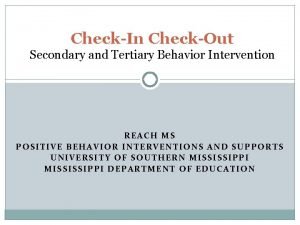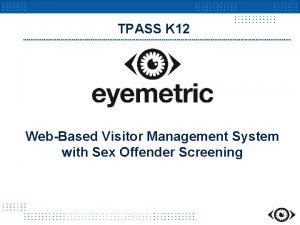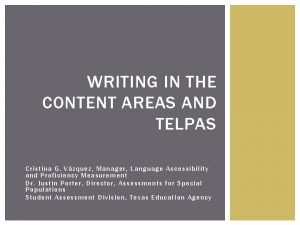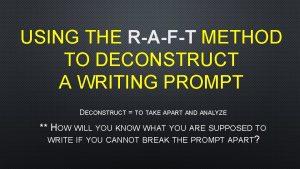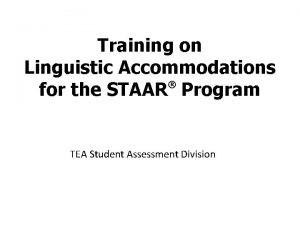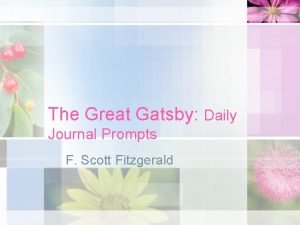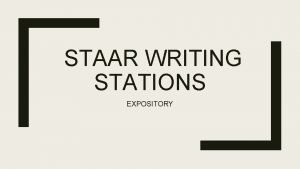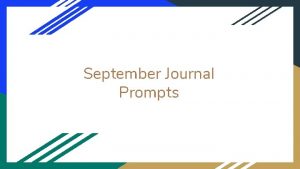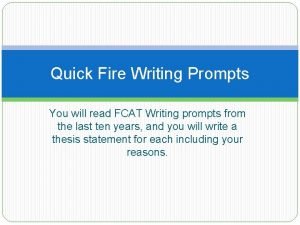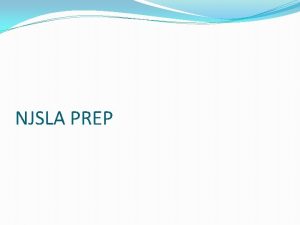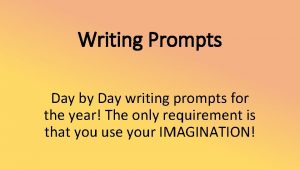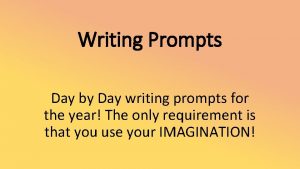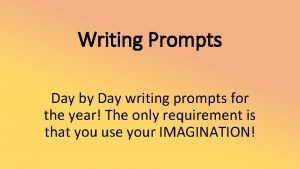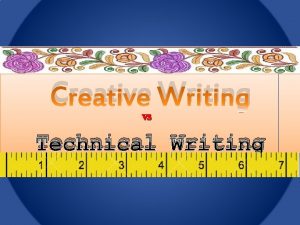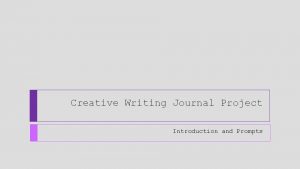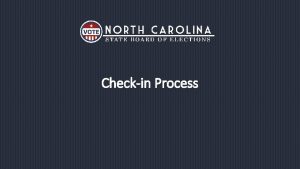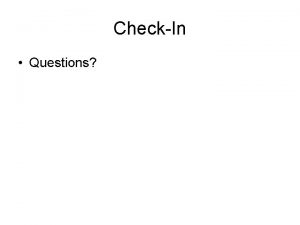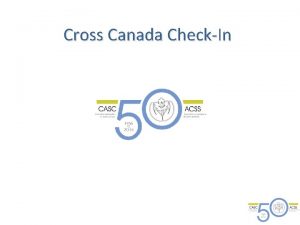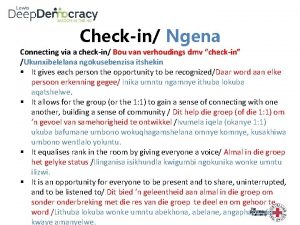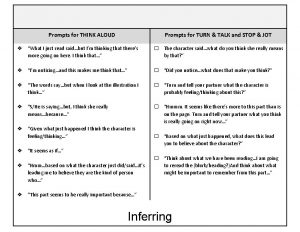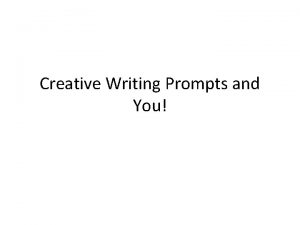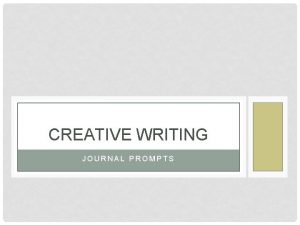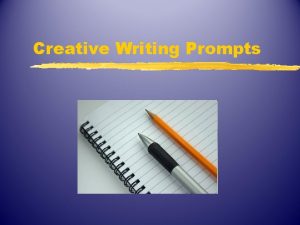AGENDA Checkin and announcements Creative writing prompts Introduction






















- Slides: 22

AGENDA • Check-in and announcements • Creative writing prompts • Introduction to short story unit • Elements of Fiction • Rules of Notice • The Kayak

WRITING PROMPTS • Today, we are starting to work with short stories • Everyone tells stories, so as we study short stories we will also work on our creative writing abilities • When you come into the classroom, check to see if there is a writing prompt on the board. If there is, start writing! • There will be 6 creative writing prompts in total

WRITING PROMPT

Short Stories a story with a fully developed theme but significantly shorter and less elaborate than a novel

WHY IS STORYTELLING IMPORTANT? • What do you think? • What stories do you remember being told? – Think about stories your parents told, or stories you hear from your friends after long absences • Why do you remember these stories? What purpose do they serve? • Examples of short stories?

EXAMPLES

STORYTELLING Stories or narratives have been shared in every culture as a means of entertainment, education, cultural preservation, and instilling moral values • Short stories explore all kinds of issues, themes, and situations found in the real world. Responding to these issues helps us make sense of the world. • Authors use various techniques to help shape the meaning and impact of their stories (Author’s craft • As critical thinkers and strategic readers, it is our job to navigate these techniques • Concentrated! • Short stories are on the provincial exam

5 ELEMENTS OF FICTION https: //www. youtube. com/watch? v=c 6 I 24 S 72 Jps

PARTS OF A SHORT STORY

PARTS OF A SHORT STORY

PARTS OF A SHORT STORY


CHARACTER The people in the story who carry out the actions. Flat - Usually minor characters who do not undergo any kind of change or growth. Not much personality. One dimensional (simple). Round – Major characters who encounter conflict and are changed by it. The character has many traits that make up a complex character. Static – Characters who do not change throughout the novel and remain the same in the end as he or she was in the beginning. Dynamic – When a character goes through an important change in the story and is not the same as they were in the beginning. The change can be in understanding, beliefs, values, etc.

CHARACTER • Major – a character that is central to the development and resolution of the story's conflict. A main character. • Minor – supporting characters who help move the story along, but they are not the main focus of the conflicts.

CHARACTER • Protagonist – the leading character, or a major character, who the story revolves around (usually the hero of the story) • Antagonist – Opposite protagonist, they are against the protagonist and cause conflict (villain)

THEME • The theme is the central idea or message behind the story. It usually provides insight on life or people in general. • The theme can be directly stated or it can be implied by the events and actions in the story.

THEME • If theme is not directly stated, ask yourself what the topic of the short story is. What is the author suggesting or saying about that topic?

SETTING • Where does the story take place? What is the time period? • The setting can set the entire mood for a story Example • Describing a dark, gloomy house or a shadowy forest can suggest something suspenseful may occur, setting the tone as well as giving details about the location. Candles flickering can either hint at romance or suggest a religious scene; adding other details will help clarify their significance.

POINT OF VIEW • Who is telling the story • Omniscient – the author tells the story and knows everything (thoughts, feelings, etc. ) • Third Person – uses “he/she” but does not know everything, such as thoughts. • First Person – told from the viewpoint of a character and uses “I”.

SOCIO-CULTURAL CONTEXT • the intersection of the social and cultural events of a certain time period that inform various phenomena such as art and political dealings • In order for us to truly access the meaning of this story we have to know more about where it is set and the implications of this setting. • Author • Time Period published/set • Music/clothes/language/dialect

RULES OF NOTICE Annotations • Title/subtitle: What observations/inferences can we make? • First and Last Sentences of the story…. What type of lead is this? What is the tone of the story? Atmosphere? How does this story end? Powerful/ reflective note? Cliffhanger? Does the end circle back and make reference to the beginning? • Repetitions: This is a box where you fill in repetitions that you have noticed in your annotations. This could be images, words, concepts

RULES OF NOTICE Annotations • Metaphors and Similes: Chronicle these throughout the annotations. Anytime you notice a metaphor or simile. Very much like poetry. • Typography: Capitalization, story structures, formatting • Spacing and Line Breaks: Paragraph Shifts, where do the turns occur? • Threats, Warnings, and Promises: From characters, foreshadowing (these are often essential to the climax of the story and to characterization) • Details Given at Climax • Erratic Behaviour/ Unusual Moments
 Pvu background
Pvu background R/announcements!
R/announcements! David ritthaler
David ritthaler Fahrenheit 451 part 3 test
Fahrenheit 451 part 3 test Potentiial
Potentiial General announcements
General announcements Agenda sistemica y agenda institucional
Agenda sistemica y agenda institucional Uci.edu login
Uci.edu login Archive ics
Archive ics What is check in check out
What is check in check out Checkin tugraz
Checkin tugraz Visitor checkin software
Visitor checkin software Pegasus check in yapma
Pegasus check in yapma Bookit finland oy
Bookit finland oy Workkeys writing examples
Workkeys writing examples Telpas writing types
Telpas writing types Rafts writing prompts
Rafts writing prompts Staar
Staar Writing prompts for the great gatsby
Writing prompts for the great gatsby Staar writing prompts english 1
Staar writing prompts english 1 September writing prompts
September writing prompts Rapid fire writing
Rapid fire writing Njsla prep
Njsla prep









